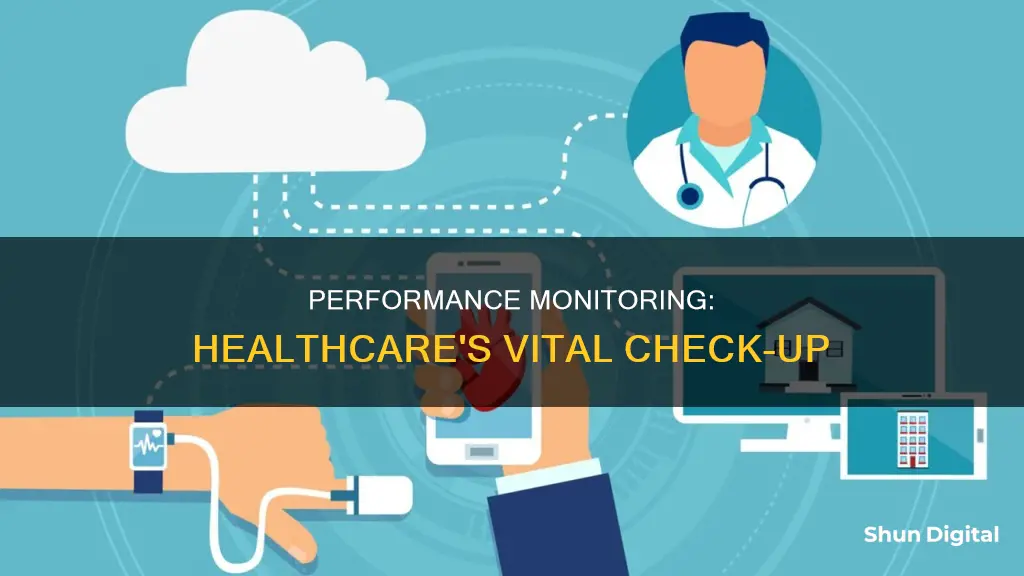
Performance monitoring in healthcare is a systematic process of evaluating and improving the delivery of healthcare services to ensure high-quality patient care. It involves collecting, analysing and interpreting data to assess performance, identify areas for improvement and make informed decisions. Performance monitoring can be applied at various levels, including individual healthcare professionals, healthcare teams, departments and organisations. It also extends to the broader community, aiming to improve the health of entire communities.
Performance monitoring in healthcare is guided by specific goals and objectives, such as improving patient outcomes, reducing wait times and increasing patient satisfaction. To achieve these goals, healthcare organisations use performance metrics and key performance indicators (KPIs) to track progress. These metrics may include clinical quality measures, patient safety indicators, operational efficiency metrics and financial performance indicators. Data sources can include electronic health records, administrative databases, patient surveys and financial reports.
Performance monitoring in healthcare also involves providing feedback to stakeholders through performance reports, which highlight areas of success and identify opportunities for improvement. Additionally, quality improvement initiatives are implemented to enhance patient care and clinical outcomes. These initiatives may involve root cause analysis, process redesign, staff training and the adoption of evidence-based practices.
Overall, performance monitoring in healthcare is a critical tool for optimising clinical outcomes, enhancing operational efficiency, improving patient satisfaction and ensuring financial sustainability. By regularly monitoring and evaluating performance, healthcare organisations can drive positive change, continuously improve healthcare delivery and ultimately enhance the health and well-being of individuals and communities.
| Characteristics | Values |
|---|---|
| Purpose | Identify opportunities for reducing costs, improving quality of care and increasing efficiency of care delivery |
| Use | Monitor other metrics to satisfy regulatory requirements |
| Types | Quality and efficiency of patient care, cost of healthcare services, disparities in performance, adherence to governmentally-mandated standards |
| Importance | People prioritise good health, governments and individuals spend a lot on healthcare, people want to make informed decisions about their healthcare, performance measurements help governments make better policies |
| Software | Software platforms can be used to streamline the EHR process and provide tools to more easily track patient outcomes and patient satisfaction |
| Prioritisation | Length of stay, readmission rates, patient satisfaction, mortality rates, bed utilisation rate, hospital incidents, CMS program performance initiatives, average cost per discharge, operating margin, bad debt |
What You'll Learn
- Performance monitoring can be used to evaluate the delivery of personal healthcare services
- Performance monitoring can be used to examine population-based public health activities
- Performance monitoring can be used to improve community health
- Performance monitoring can be used to improve quality of care
- Performance monitoring can be used to reduce costs and increase efficiency

Performance monitoring can be used to evaluate the delivery of personal healthcare services
Performance monitoring in healthcare is a systematic process of evaluating and improving the delivery of personal healthcare services and public health activities. It involves collecting, analysing, and interpreting data on various aspects of healthcare performance to identify areas for improvement and make informed decisions. Performance monitoring can be used to evaluate the delivery of personal healthcare services in several ways:
Setting Performance Goals and Objectives
Performance monitoring helps healthcare organisations establish clear goals and objectives that align with their mission, vision, and strategic priorities. These goals may include improving patient outcomes, reducing wait times, and increasing patient satisfaction. For example, performance monitoring can help identify areas where wait times are excessively long and resources need to be allocated more efficiently.
Performance Measurement and Metrics
Performance metrics and key performance indicators (KPIs) are essential tools in performance monitoring. They help track progress toward organisational goals and identify areas for improvement. Examples of performance metrics include clinical quality measures, patient safety indicators, operational efficiency metrics, and financial performance indicators. By monitoring these metrics, healthcare providers can identify areas where they are falling short and make necessary improvements.
Data Collection and Analysis
Performance monitoring involves collecting and analysing data from various sources, such as electronic health records (EHRs), administrative databases, patient surveys, and financial reports. This data is then interpreted to assess current performance levels and identify areas that need improvement. For instance, data analysis may reveal that a particular department has higher-than-average patient satisfaction scores, and the practices that contribute to this success can then be implemented elsewhere.
Performance Reporting and Feedback
Performance monitoring includes regularly reporting performance data to stakeholders, including healthcare leaders, clinicians, and staff. These reports provide feedback on progress toward goals and highlight areas that require improvement. For example, performance monitoring may reveal that a specific department is consistently falling short of patient safety goals, prompting targeted interventions to address this issue.
Quality Improvement Initiatives
Performance monitoring is closely tied to quality improvement initiatives. By identifying areas of weakness through performance monitoring, healthcare organisations can implement targeted interventions to enhance patient care, clinical outcomes, and organisational processes. For instance, root cause analysis, process redesign, and staff training may be implemented to address persistent issues.
Employee Performance Management
Performance monitoring is not limited to organisational performance but also extends to individual employees. Healthcare organisations use performance appraisal systems, feedback mechanisms, and professional development opportunities to support and improve staff performance. For example, performance monitoring may reveal that a particular nurse consistently provides exceptional patient care, and this can be recognised and rewarded accordingly.
Patient Experience Management
Performance monitoring includes efforts to measure and improve the patient experience. Healthcare organisations collect patient feedback through surveys, focus groups, and other means to identify areas where they can better meet patient needs and expectations. For instance, performance monitoring may reveal that patients consistently rate their communication with medical staff as poor, prompting initiatives to improve staff communication skills and responsiveness to patient concerns.
Continuous Improvement Culture
Performance monitoring fosters a culture of continuous improvement within healthcare organisations. It encourages staff to identify opportunities for innovation, efficiency, and quality enhancement. By creating a culture that values ongoing evaluation and refinement, healthcare organisations can drive positive change and achieve organisational excellence.
In summary, performance monitoring in healthcare provides a systematic approach to evaluating and improving the delivery of personal healthcare services. By collecting and analysing data, identifying areas for improvement, and implementing targeted interventions, healthcare organisations can enhance the quality and efficiency of care they provide, ultimately improving patient outcomes and experiences.
Monitoring Data Usage: WWDRT for Precise Device Tracking
You may want to see also

Performance monitoring can be used to examine population-based public health activities
Performance monitoring is a tool used to evaluate the delivery of personal healthcare services and examine population-based public health activities. It involves collecting, analysing and interpreting data to assess performance, identify areas for improvement and inform decision-making. Performance monitoring can be used to examine population-based public health activities by tracking key indicators and metrics related to public health outcomes. This includes monitoring health trends, identifying health priorities and evaluating the impact of public health interventions.
Performance monitoring can help public health agencies and organisations assess and improve their performance in delivering population-based healthcare services. By tracking relevant indicators and metrics, public health agencies can evaluate the effectiveness of their programmes and policies in improving the health of the community. For example, performance indicators can be used to monitor immunisation rates, infectious disease incidence, environmental health hazards and other factors that impact population health. This information can then be used to identify areas where public health interventions are needed and to assess the impact of these interventions over time.
Performance monitoring can also facilitate collaboration and coordination among different stakeholders in population health. By sharing performance data and establishing common goals, public health agencies, healthcare providers and community organisations can work together to improve population health outcomes. For instance, performance monitoring can help identify shared interests and promote collaboration between public health agencies and community groups, leading to more effective community health initiatives. Additionally, performance monitoring can enhance accountability and transparency in population health by providing clear criteria for evaluating the performance of public health organisations and their adherence to established standards.
Furthermore, performance monitoring plays a crucial role in policy development and strategic planning for population health. By tracking key indicators and conducting regular evaluations, public health agencies can identify emerging health issues, set priorities and develop evidence-based policies to address population health needs. Performance monitoring also enables the allocation of resources and funding based on identified priorities and areas of concern. This ensures that public health interventions are targeted and aligned with the specific needs of the population.
Lastly, performance monitoring is essential for evaluating the impact of public health interventions and determining their effectiveness in improving population health outcomes. By regularly monitoring relevant indicators and conducting evaluations, public health agencies can assess whether their programmes and policies are achieving the desired outcomes. This allows for the identification of successful interventions that can be replicated and scaled up, as well as interventions that need modification or alternative approaches. Overall, performance monitoring provides a systematic approach to evaluating and improving population-based public health activities, ultimately contributing to better health outcomes for communities.
The Monitor Conundrum: 27-Inch 1080p Display Worth Buying?
You may want to see also

Performance monitoring can be used to improve community health
Performance monitoring in healthcare is a systematic process of evaluating and improving the delivery of healthcare services to individuals and communities. It involves collecting and analyzing data on various aspects of healthcare, including clinical outcomes, operational efficiency, patient satisfaction, and financial sustainability. By identifying areas for improvement, healthcare providers can enhance the quality and efficiency of their services, ultimately improving community health.
Identifying and Addressing Health Disparities
Performance monitoring allows healthcare providers to identify and address health disparities within a community. By collecting and analyzing data on various demographic factors, such as age, gender, ethnicity, income, and education, healthcare providers can identify specific health needs and challenges faced by different community groups. This information can then be used to develop targeted interventions and improve health outcomes for underserved or vulnerable populations.
Enhancing Healthcare Accessibility and Equity
Performance monitoring can help improve healthcare accessibility and equity within a community. By tracking metrics such as wait times, bed utilization rates, and patient transportation services, healthcare providers can identify barriers to accessing healthcare services. This information can inform the development of initiatives to enhance transportation services, reduce wait times, and improve the overall accessibility of healthcare facilities for community members.
Strengthening Community Engagement and Collaboration
Performance monitoring encourages collaboration and engagement between healthcare providers and the community. By involving community members in the data collection and analysis process, healthcare providers can gain valuable insights into the specific health needs and concerns of the community. This collaborative approach promotes trust, ensures that interventions are culturally appropriate, and increases community buy-in for health improvement initiatives.
Informing Public Health Policy and Planning
Performance monitoring provides valuable data to inform public health policy and planning at the local, state, and national levels. By tracking health indicators and community health trends, healthcare providers and policymakers can identify areas requiring additional resources or interventions. This information can guide the allocation of public health funding, the development of health promotion programs, and the implementation of preventive measures to address specific community health needs.
Driving Continuous Improvement in Healthcare Delivery
Performance monitoring fosters a culture of continuous improvement within healthcare organizations. By regularly monitoring and evaluating performance, healthcare providers can identify areas for enhancement and implement evidence-based interventions. This may include improving clinical processes, adopting new technologies, or refining patient care protocols to enhance the overall quality and efficiency of healthcare delivery, ultimately improving health outcomes for the community.
Promoting Accountability and Transparency
Performance monitoring promotes accountability and transparency in healthcare. By establishing clear performance metrics and goals, healthcare providers can measure their progress and identify areas for improvement. Transparent reporting of performance data to stakeholders, including community members, fosters trust and enables informed decision-making. It also encourages healthcare providers to continuously strive for excellence and be accountable to the communities they serve.
Touchscreen Monitors: Understanding Their Various Sizes
You may want to see also

Performance monitoring can be used to improve quality of care
Performance monitoring in healthcare is a systematic process of evaluating and improving the delivery of healthcare services and patient outcomes. It involves collecting and analyzing data on various aspects of healthcare, including clinical quality, patient safety, operational efficiency, and financial performance. By tracking key performance indicators and metrics, healthcare organizations can identify areas for improvement and make informed decisions to enhance the quality of care and patient satisfaction.
Performance monitoring can be used to improve the quality of care in several ways:
Setting Clear Performance Goals and Objectives
Performance monitoring begins with establishing clear and measurable goals that are aligned with the healthcare organization's mission, vision, and strategic priorities. These goals provide direction and help focus efforts on areas that need improvement. For example, goals may include improving patient outcomes, reducing wait times, or increasing patient satisfaction.
Tracking Key Performance Indicators (KPIs) and Metrics
Healthcare organizations use performance metrics and KPIs to track progress toward their goals. These metrics may include clinical quality measures, such as infection rates or readmission rates, patient safety indicators, such as adverse event reports, and operational efficiency metrics, such as length of hospital stays or bed utilization rates. Financial performance indicators are also crucial for ensuring the financial sustainability of healthcare organizations.
Data Collection and Analysis
Performance monitoring involves collecting, analyzing, and interpreting data from various sources, such as electronic health records (EHRs), administrative databases, patient surveys, and financial reports. By analyzing this data, healthcare organizations can assess their current performance, identify gaps or areas for improvement, and make data-driven decisions to enhance the quality of care.
Regular Performance Reporting and Feedback
Performance data is regularly reported to stakeholders, including healthcare leaders, clinicians, staff, and external regulatory agencies. These performance reports provide feedback on progress toward goals, highlight areas of success, and identify opportunities for improvement. Transparent reporting fosters accountability and enables stakeholders to work collaboratively toward enhancing the quality of care.
Implementing Quality Improvement Initiatives
Performance monitoring is closely linked to quality improvement initiatives. Once areas for improvement are identified through data analysis, healthcare organizations can implement interventions and strategies to enhance patient care and clinical outcomes. This may involve root cause analysis to identify the underlying causes of performance gaps, process redesign to streamline workflows, staff training to enhance skills and competencies, and the implementation of evidence-based practices that have proven effective in improving patient outcomes.
Continuous Monitoring and Evaluation
Performance monitoring is an ongoing process that requires continuous monitoring and evaluation. Healthcare organizations should regularly review performance data, identify trends, and adjust their strategies accordingly. This continuous improvement culture encourages staff to actively look for opportunities to enhance the quality and efficiency of care delivery.
Regulatory Compliance and Accreditation
Performance monitoring also ensures that healthcare organizations comply with regulatory requirements and accreditation standards established by external agencies. By monitoring performance metrics related to regulatory compliance, healthcare organizations can identify and address any deficiencies and maintain the highest standards of care.
By utilizing performance monitoring effectively, healthcare organizations can drive positive change, enhance the patient experience, and ultimately improve health outcomes for individuals and communities. It enables healthcare professionals and organizations to identify areas where they are excelling and areas that need improvement, leading to data-informed decisions and interventions that benefit patients and the healthcare system as a whole.
Finding the Perfect 1080p Monitor: Maximizing Your Viewing Experience
You may want to see also

Performance monitoring can be used to reduce costs and increase efficiency
Performance monitoring in healthcare is a systematic process of evaluating and improving the delivery of healthcare services to ensure safe, high-quality, accessible, and sustainable healthcare for patients and communities. It involves collecting, analysing, and interpreting data to assess performance, identify areas for improvement, and make informed decisions. Performance monitoring can be used to reduce costs and increase efficiency in healthcare delivery. Here's how:
Identifying Opportunities for Cost Reduction and Efficiency Improvement
Performance monitoring involves tracking various performance metrics and key performance indicators (KPIs) that provide insights into areas where costs can be reduced and efficiency can be improved. For example, by monitoring metrics such as length of stay, readmission rates, patient satisfaction, mortality rates, and bed utilisation rate, healthcare organisations can identify areas where efficiencies can be gained and costs can be optimised.
Enhancing Operational Efficiency
By closely monitoring operational efficiency metrics, healthcare organisations can identify bottlenecks, redundant processes, or areas of high resource consumption. For instance, tracking bed utilisation rates can help hospitals optimise staffing and maintenance costs. Similarly, monitoring hospital incident metrics can help identify areas where improvements can be made to reduce adverse events and enhance patient safety.
Streamlining Processes and Resource Allocation
Performance monitoring enables healthcare providers to streamline processes and optimise resource allocation. For instance, by analysing patient flow data, wait times, and staff productivity metrics, healthcare organisations can identify bottlenecks, redundant steps, or areas where additional resources are needed. This information can then be used to redesign processes, improve workflow efficiency, and allocate resources more effectively, leading to reduced costs and improved efficiency.
Identifying Gaps and Inefficiencies
Performance monitoring helps identify gaps and inefficiencies in healthcare delivery, which can drive targeted interventions to improve efficiency and reduce costs. For example, monitoring patient satisfaction surveys and feedback can uncover areas where patients feel delays or inefficiencies exist, such as long wait times or cumbersome administrative processes. This information can then be used to streamline processes and improve the patient experience.
Continuous Improvement and Best Practice
Performance monitoring fosters a culture of continuous improvement by encouraging the identification and implementation of best practices. By regularly monitoring performance data and identifying areas for improvement, healthcare organisations can develop and implement evidence-based interventions to enhance efficiency and reduce costs. Additionally, sharing performance data and successful initiatives across departments or teams can promote the spread of best practices throughout the organisation.
Regulatory Compliance and Accreditation
Performance monitoring ensures compliance with regulatory requirements and accreditation standards, which can help avoid costly penalties and maintain funding. By closely monitoring performance metrics related to regulatory compliance, healthcare organisations can identify and address any deficiencies promptly. This proactive approach can help maintain accreditation, avoid disruptions in operations, and reduce potential financial losses associated with non-compliance.
Sienna LE: Blind Spot Monitoring and Other Safety Features
You may want to see also
Frequently asked questions
Performance monitoring in healthcare is the process of systematically evaluating and improving the performance of healthcare organisations, professionals, and systems to achieve their goals and deliver high-quality patient care. Performance monitoring involves collecting and analysing data on various aspects of healthcare delivery, such as clinical outcomes, operational efficiency, patient satisfaction, and financial sustainability. This data is then used to identify areas for improvement and inform decision-making.
Performance monitoring is important in healthcare because it helps to ensure that healthcare organisations are delivering high-quality, safe, and effective care to patients. By monitoring and evaluating healthcare processes, patient outcomes, and experiences, performance monitoring contributes to optimising the overall quality and safety of care. Additionally, performance monitoring helps to enhance operational efficiency, promote accountability and transparency, drive continuous improvement, ensure regulatory compliance, support strategic planning, and improve stakeholder satisfaction and engagement.
The key components of performance monitoring in healthcare include:
- Setting clear performance goals and objectives that align with the organisation's mission and vision.
- Defining performance metrics and key performance indicators (KPIs) to track progress toward these goals.
- Collecting, analysing, and interpreting performance data from various sources, such as electronic health records and patient surveys.
- Providing regular performance reports and feedback to stakeholders, including healthcare leaders and external regulatory agencies.
- Implementing quality improvement initiatives to enhance patient care and clinical outcomes.
- Extending performance management to individual employees, including clinicians and administrative staff, through performance appraisals and professional development opportunities.
- Measuring and improving the patient experience through patient feedback and satisfaction surveys.
- Managing risks and enhancing patient safety through safety protocols and adverse event analyses.
- Fostering a continuous improvement culture within the organisation.
- Ensuring regulatory compliance and accreditation by monitoring performance against established standards.
Performance monitoring contributes to improving healthcare outcomes by driving positive change and innovation within healthcare organisations. By systematically monitoring performance, identifying areas for improvement, and implementing evidence-based interventions, healthcare organisations can enhance the quality and effectiveness of healthcare delivery. This, in turn, leads to better health outcomes for individuals and communities. Additionally, performance monitoring helps to ensure that healthcare resources are used efficiently and effectively, ultimately improving the overall health and well-being of the population.







